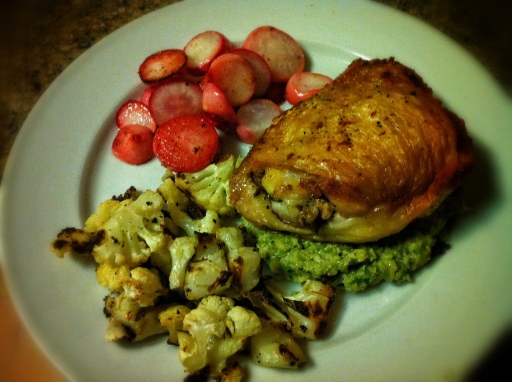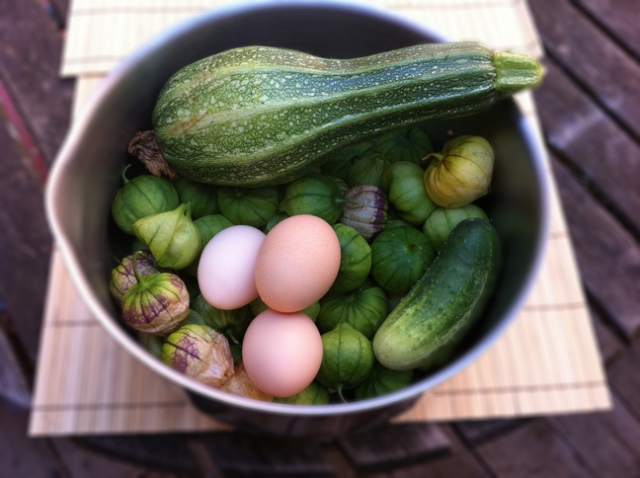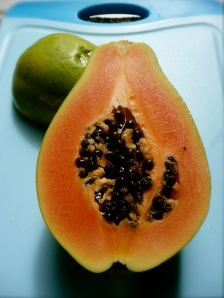Back in the mists of time — during the Soup365 experiment, to be exact — I was attempting to cook and blog a soup a day. Most of the soups were just fine. Some were goddamn delightful. And a few… a very few… were deep existential disappointments.
Soup #51: Broccoli-Cheese Soup was such a one. I still recall my bitter annoyance at its drab color, its unappealing sameish texture, its startling lack of distinct flavor. So I have largely avoided making any sort of veggie-cheese soup ever since.
But Friday was dreary and rain and blah, perfect soup weather, and I didn’t much feel like cooking up any sort of hunk of meat. So at Fisher’s enthusiastic agreement, I essayed a new take on broccoli-cheese soup, going by feel rather than recipe. And I think I can say, quite honestly, that this soup has been redeemed. The mustard gives it a delightful zip that cuts through the decadence of cream and cheese, and cooking the broccoli separately keeps it both brightly colored and sprightly flavored.
Re: cooking the broccoli separately — I recently picked up this awesome set of Instant Pot accessories, which included two different spins on steamer racks/baskets. The little footed basket was perfect for steaming the broccoli (as it would be for any little fiddly bits of food). The mesh is fine enough to keep everything contained while it bathes in the steam. The set also includes goodies like a double egg steaming rack, silicone egg bites mold, mini cheesecake pan, and three handy-dandy fridge magnets printed with Instant Pot cooking times for all sort of food. Well worth the $32!
No pictures of the soup, sorry–but it was a lovely golden color!
Broccoli-Cheese Soup
I thought it would make leftovers, but three of us managed to polish off the whole pot. Would be quite easy to double.
2 medium crowns broccoli, chopped into roughly 1/2″ pieces
4 Tbsp butter or ghee
1 large yellow onion, very finely diced
Plenty of salt
3 cloves garlic, minced
1 tsp hot ground mustard
2-3 tsp Northwoods Seasoning from Penzeys (it’s a mix of coarse salt, paprika, black pepper, thyme, rosemary, granulated garlic, and ground chipotle–super useful and I recommend getting some!)
1/4 cup all-purpose flour
2-1/2 cups chicken or vegetable broth (I used, as ever, Better-than-Bouillon)
1/2 cup heavy cream and 1-1/2 cups milk, or 1 cup half-and-half and 1 cup milk
2 packed cups grated sharp cheddar (I used Tillamook Extra Sharp)
Freshly ground black pepper
Steam the broccoli briefly until just tender; set aside. (I gave mine 4 minutes on Steam in the Instant Pot and it was perfect.)
Melt butter over medium-low heat. Add onion and a few generous pinches of salt. Sweat, stirring occasionally, until onion is wholly translucent and beginning to brown in places, about 10 minutes. Add garlic, mustard, and Northwoods Seasoning and cook, stirring, until garlic becomes fragrant, about 30 seconds more.
Increase heat to medium and whisk in flour. Cook, stirring constantly, until flour loses raw smell and color, about 1 minute. Gradually whisk in broth, then cream/milk mixture. Allow to simmer for a few minutes (this is a fine time to grate the cheese). Whisk in cheese, bit by bit, until melted.
Add broccoli and heat through. Taste and add salt and plenty of pepper to taste.
Serve with crusty bread or hot biscuits. Mmmmm.







